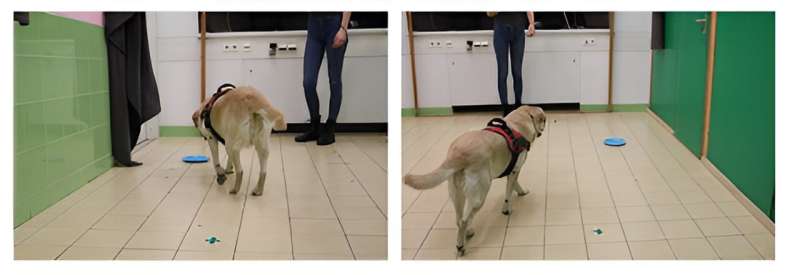How Smarter Dogs Perceive Objects: Insights into Their World

November 18, 2023
This editorial has undergone a review process in accordance with the policies and procedures of Science X. In order to ensure the integrity of the content, editors have emphasized the following:
- fact-checked
- trusted source
- proofread
by Eötvös Loránd University
When interacting with toddlers and dogs, there is an interesting observation: if an object is pointed at, the toddler will concentrate on the object, whereas the dog typically sees the gesture more as an indication of direction.
A recent study conducted by researchers at the Department of Ethology at Eötvös Loránd University provides insight into why this difference in perception exists. The study suggests the difference is not solely due to the vision of dogs but may also illustrate their cognitive process. For dogs deemed 'smarter', the physical appearance of an object is just as vital as its location, implying that their cognitive processing is more human-like.
Spatial bias is a phenomenon where information is interpreted based on location, space, and distance, even when it could also apply to an object.
'In situations where we use gestures to indicate an object's position, the reactions of dogs and children offer an example of this bias. Typically, children perceive the gesture as referring to the object, whereas dogs interpret the pointing as a directional indicator. This happens irrespective of the person's intent when giving the cue; children and dogs assign different meanings to it,' explained Ivaylo Iotchev, lead author of the study published in the journal Ethology.
'Observations of this phenomenon have been made previously in dogs through a variety of behavior tests, like imitation and simple associative learning, but there was no research dedicated to it.'
The investigators concluded that spatial bias offers an untapped opportunity to improve our understanding of canine cognition.
Prior studies have not determined whether dogs behave this way because their vision is worse in comparison to primates, or if it is an information processing bias, meaning dogs care more about their surroundings than specific objects nearby.
In the study, the research team used two behavior tests involving 82 dogs to measure spatial bias. In the first task, the dogs had to learn over a maximum of 50 trials whether the treat was always placed on the right or left plate, essentially learning its location.
In the second task, two types of plates were used - one round and white, the other square and black. These plates were always centrally placed. The dogs were only allowed to eat from one type of plate, presented in a semi-random sequence. In this scenario, they were learning about the characteristics of the plate. The speed they approached the right plate was an indicator of how well they had learned.
The results indicated that the dogs learned quicker when the treat was placed towards the right or left, requiring them to choose a direction. They had more difficulty remembering whether the treat was on the white round plate or the black square one. The 'spatial bias' metric described how much faster they were at learning location over object features.
After the dogs had learned where the treat was located, the challenge increased as the treat's location was reversed. For example, if the treat was initially on the right, it was now on the left and vice versa for the plate colors.
In order to determine whether the spatial bias is sensory, cognitive or a combination of both, the researchers had to identify and quantify differences in dogs' cognitive and visual abilities.
This process involved assessing the length of the dog's head (because it's linked to visual acuity) and evaluating their problem-solving effectiveness.
Zsófia Bognár, a doctoral student, and co-author assisted in studying the head shape.
'Dog breeds have different visual abilities, which are indirectly affected by their head shape. Dogs with shorter heads (brachycephalic) have vision that is more similar to human vision. Their retina structure suggests sharper focus compared to dogs with longer heads. This is why we used a measure of head shape (also known as cephalic index) as an approximate evaluation of visual quality in dogs. It's calculated by dividing the skull width by the skull length. The shorter the head, the higher the number,' Zsófia Bognár explained.
To measure cognitive ability, the dogs took part in a series of tests. 'We tested their memory, attention skills and perseverance. We found that dogs with better cognitive performance in the more difficult spatial bias task linked information to objects as easily as to places. We also see that as children develop, spatial bias decreases with increasing intelligence,' added Eniko Kubinyi, head of the MTA- 'Lendület' Momentum Companion Animal Research Group.
The study found that spatial bias is smaller in dogs with better visual acuity and who are 'smarter.' 'Spatial bias in dogs is not simply a sensory problem but also a mindset. We also found that 'smarter' dogs are resilient in difficult learning situations and can overcome their biases,' said Iotchev.
Provided by Eötvös Loránd University




